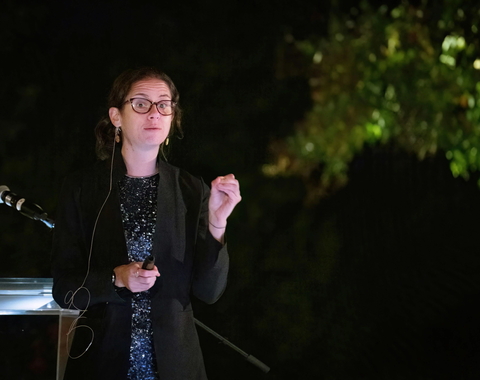Washington, DC—The James Webb Space Telescope has captured the first clear, detailed, indisputable evidence for atmospheric carbon dioxide ever detected on a planet outside the Solar System. The discovery was announced by the mission’s Transiting Exoplanet Community Early Release Science Team, which includes four Carnegie astronomers—Munazza Alam, Anjali Piette, Peter Gao, and Johanna Teske. It will be published next week in Nature.
As part of the team’s efforts in July and August, JWST observed a gas giant planet, called WASP-39 b, which orbits a Sun-like star 700 light-years from Earth. Their finding offers thrilling evidence of JWST’s capabilities and provides important insights into the link between planetary formation and composition.
“As we have discovered thousands of exoplanets over the past two and a half decades, we’ve realized that most other planetary systems are very different from our own,” explained Gao. “The leap that JWST is enabling in our ability to study exoplanet atmospheres will significantly advance our knowledge of how they are shaped by their host star’s composition and planetary system’s evolution, which may provide answers about why our Solar System is so different.”
First discovered in 2011, WASP-39 b is a hot gas giant with about the same mass as Saturn and a diameter 1.3 times greater than Jupiter. Its extreme “puffiness” is related in part to its high temperature of about 1,600 degrees Fahrenheit, or 900 degrees Celsius. Unlike the cooler, more compact, gas giants in our Solar System, WASP-39 b orbits very close to its star at a distance only about one-eighth that between the Sun and Mercury, completing its orbit in just over four Earth days.
WASP-39 b was initially discovered using ground-based detections of the subtle, periodic dimming of light from its host star as the planet passed in front of it. So-called transiting planets like this present astronomers with ideal opportunities to probe their atmospheres.
During a transit, some of the starlight is filtered through the planet’s atmosphere.
“Depending on the atmosphere’s composition, thickness, and cloudiness, it absorbs some colors of light more than others—making the planet appear larger,” said Alam. “We can analyze these miniscule differences in the size of the planet to reveal the atmosphere’s chemical makeup.”
“Detecting such a clear signal of carbon dioxide on WASP-39 b bodes well for the detection of atmospheres on smaller, terrestrial-sized planets,” added Natalie Batalha of the University of California at Santa Cruz, who leads the team of researchers using JWST to study transiting exoplanets.
The Early Release Science program, which represents 22 different research institutions, was designed to provide the research community with robust data from JWST as quickly as possible.
“Our team’s work will continue through December and include observations of WASP-39 b and two other transiting planets using a variety of JWST instruments, meaning more discoveries are just over the horizon,” said Piette.
This is one of several JWST teams involving Carnegie astronomers, including six projects headed up by Carnegie scientists—Gao and Teske are both leads on separate JWST investigations of exoplanet atmospheres—and several others on which Carnegie staff and postdocs are team members.
Teske concluded: “The technical capabilities of this telescope are just humbling. Every data set is like a new adventure, with perils to be wary of and understand, but a fascinating reward at the end!"



